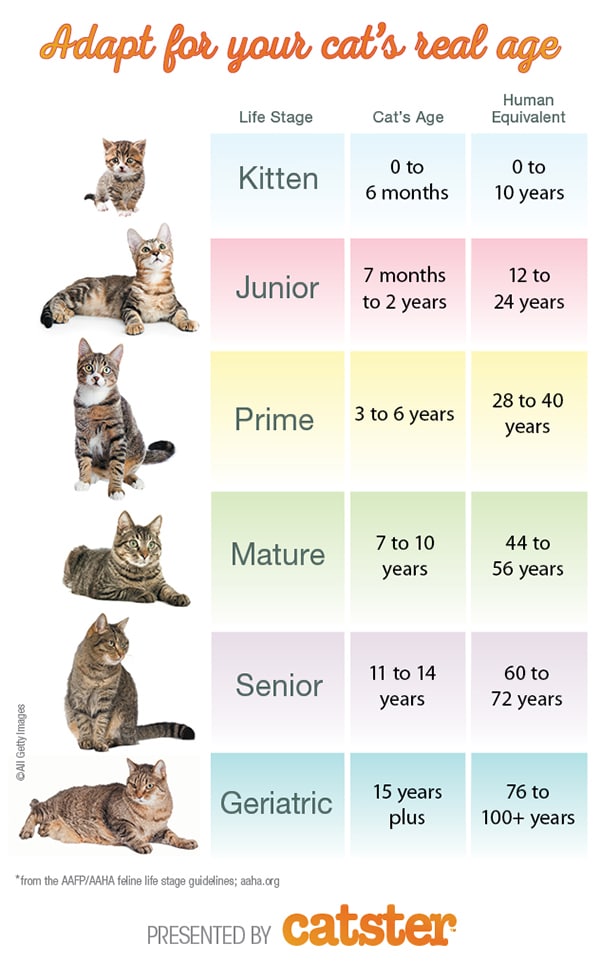How to Calculate Cat Years to Human Years
The post How to Calculate Cat Years to Human Years by Catster HQ appeared first on Catster. Copying over entire articles infringes on copyright laws. You may not be aware of it, but all of these articles were assigned, contracted and paid for, so they aren't considered public domain. However, we appreciate that you like the article and would love it if you continued sharing just the first paragraph of an article, then linking out to the rest of the piece on Catster.com.
A popular misconception is that cats age seven years (in human years) for each calendar year. In fact, feline aging is much more rapid during the first two years of life. A cat reaches the approximate human age of 15 during his first year, then 24 at age 2. Each year thereafter, a cat ages approximately four cat years for every calendar year. Thus, a cat who is 5 in cat years would be approximately 36 in human years.
Note: It should be remembered that a cat who lives outdoors ages far more quickly, perhaps even twice as fast, than an indoor cat. Scroll to the bottom of this article to find out more about cat years to human years for outdoor cats.
Indicators of a Cat’s Age
A cat’s teeth can indicate a cat’s age in cat years. Photography ©Seiichi Tanaka | iStock / Getty Images Plus.
If you’ve taken in a stray cat or adopted a cat whose age is unknown, there are some ways to determine her age in cat years. Here are some things vets check to get a general sense of how old a cat is in cat years:
- A Cat’s Teeth: Teeth are a great indicator of a cat’s age in cat years. Older cats tend to have more staining than younger cats, assuming the previous owner was negligent in brushing the cat’s teeth. And a kitten’s teeth first come in between two to four weeks; their more permanent set appears at around four months of age. So if you open a cat’s mouth and find permanent, white teeth, the feline is likely to be around a year old. Some yellowing might place the cat between 1 and 2, and tartar build-up on all the teeth indicates that the cat could be between 3 and 5. Missing teeth may mean you have a senior cat on your hands.
- A Cat’s Muscle Tone: Younger cats are more likely to have some muscle definition from their higher activity level. Older cats are usually a bit bonier and may have some extra skin hanging or protruding shoulder blades.
- A Cat’s Coat: The condition of a cat’s coat is another great indicator of a kitty’s age in cat years. Kittens and younger cats usually have soft, fine coats, whereas older cats tends to have thicker, coarser fur. A senior cat may display grays or patches of white.
- A Cat’s Eyes: Bright, clear eyes without tearing or eye discharge are common in younger cats. A cat with some cloudiness in their eyes is likely to be 12 years old or so. While inspecting the lens, also examine the iris of the eye. Young cats have smooth irises, while the iris of an old cat can sometimes appear somewhat jagged.
A Cat’s Life Span
Felines are generally quite long-lived, though mileage varies depending on owner maintenance and genetic predisposition. In a handful of documented cases, cats have exceeded 30 years in age. Typically, indoor cats may live 12 to 18 years, with many surviving into their 20s.
Outdoor Cats Life Expectancy — How Long Do Outdoor Cats Live, in Cat Years?
Outdoor cats can have a significantly shorter life span then indoor-only cats, often living only two to five years. Pet parents in urban and suburban areas are strongly encouraged to keep their cats indoors.
Free-roaming cats are in danger of injury or even death by:*
- vehicles
- attacks from other animals
- human cruelty
- poison
- traps
- disease
*Source: AVMA’s position statement
Use this cat years chart for a better understanding of cat years to human years:
Tell us: How old is your cat in cat years? How old is your cat in human years?
Thumbnail: Photography © Indiah | Thinkstock.
This piece was originally published in 2017.
Read more about cat years and a cat’s life on Catster.com:
The post How to Calculate Cat Years to Human Years by Catster HQ appeared first on Catster. Copying over entire articles infringes on copyright laws. You may not be aware of it, but all of these articles were assigned, contracted and paid for, so they aren't considered public domain. However, we appreciate that you like the article and would love it if you continued sharing just the first paragraph of an article, then linking out to the rest of the piece on Catster.com.





Post a Comment